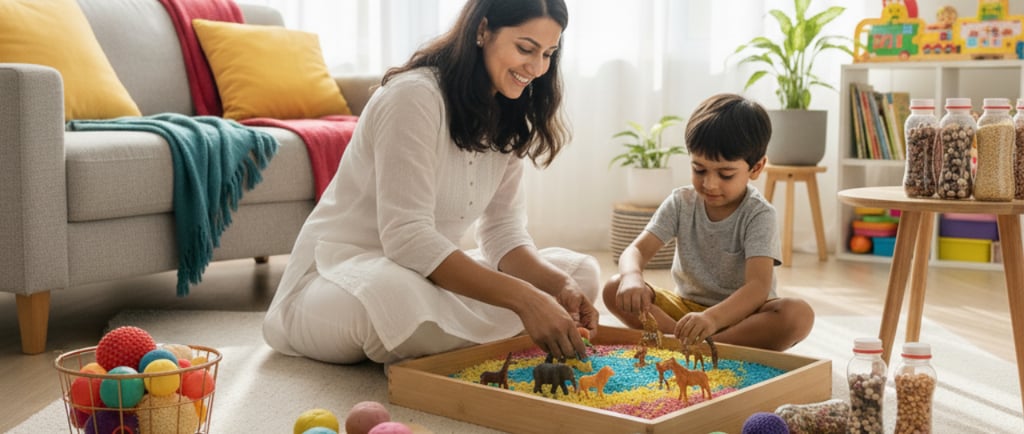10 Engaging Sensory Play Activities to Try at Home
Powerful sensory home-based activities to try at home
OCCUPATIONAL THERAPYSENSORY INTEGRATION
Dr. Dipak Kumar
10/1/20253 min read


Children learn best when they explore with their senses—touch, sight, sound, smell, and movement. For many kids, especially those with sensory processing challenges, play that stimulates the senses can be calming, enjoyable, and very beneficial for development. The good news? You don’t need expensive toys or equipment to support your child. With a few simple household items, you can create fun sensory play activities right at home.
Here are 10 engaging, low-cost sensory play ideas that Indian parents can try to encourage sensory exploration and learning.
1. Sensory Bin with Rice or Beans
Fill a large tub with rice, dal, or beans. Add small cups, spoons, or toy animals for scooping, pouring, and hiding.
Why it helps: Builds fine motor skills, tactile exploration, and focus.
Parent tip: You can dye rice with food color for a more colorful experience.
2. Water Play with Cups and Toys
A bucket or basin of water with cups, ladles, or floating toys can keep children engaged for long.
Why it helps: Encourages hand-eye coordination and provides calming sensory input.
Parent tip: Add a few drops of soap and let your child wash their toy cars or dolls.
3. Homemade Playdough or Atta Dough
Use wheat flour (atta) mixed with a little oil, salt, and water to make soft, safe dough. Kids can roll, squeeze, and shape it.
Why it helps: Strengthens hand muscles, creativity, and tactile tolerance.
Parent tip: Add haldi or food color for natural colors, or a drop of vanilla essence for smell.
4. Texture Scavenger Hunt
Ask your child to find items around the house that feel rough, smooth, soft, or hard (like a towel, spoon, cotton ball, or stone).
Why it helps: Improves awareness of textures and supports vocabulary development.
Parent tip: Turn it into a game by timing how quickly they can find each item.
5. Sensory Bowling
Use plastic bottles filled with rice, coins, or pebbles to create “pins.” Roll a textured ball (rubber, spiky, or even a rolled-up pair of socks) to knock them down.
Why it helps: Combines tactile play, gross motor coordination, and cause-and-effect learning.
Parent tip: Decorate bottles with stickers or colored tape to make it more exciting.
6. Nature Walk Basket
Take a small basket outdoors and collect leaves, flowers, twigs, or pebbles. Back at home, explore their textures, smells, and colors.
Why it helps: Connects children with nature while stimulating multiple senses.
Parent tip: Encourage your child to sort the items by color, size, or texture.
7. Balloon Play with Different Fillings
Fill balloons with flour, rice, or water (tie them tightly). Children can squeeze, press, or toss them.
Why it helps: Offers varied tactile input and helps with stress release.
Parent tip: Supervise closely to avoid popping hazards, and double-layer the balloons for safety.
8. Homemade Musical Shakers
Use empty plastic bottles or small jars filled with dal, rajma, or small stones. Let children shake and dance to the sound.
Why it helps: Develops auditory awareness, rhythm, and movement coordination.
Parent tip: Try filling bottles with different materials to create varied sounds.
9. Sensory Obstacle Course
Set up cushions, chairs, and mats to crawl under, climb over, or balance on. Add fun stops like touching a textured mat or carrying a weighted pillow.
Why it helps: Stimulates the vestibular (balance) and proprioceptive (body awareness) senses.
Parent tip: Keep it safe by supervising closely and using soft furniture.
10. Spice Smelling Jars
Fill small jars or containers with common Indian spices like cardamom, cinnamon, cloves, or fennel. Let your child smell and guess the spice.
Why it helps: Strengthens the sense of smell, builds memory, and introduces cultural flavors.
Parent tip: Use only mild spices and avoid letting your child taste directly.
Sensory play is not just fun—it’s a meaningful way to support your child’s development. By using simple, everyday items, you can create rich sensory experiences that improve focus, motor skills, and emotional regulation.
Remember, every child responds differently. Some may love messy play, while others may need time to adjust. The goal is to keep activities playful, safe, and pressure-free. Over time, these sensory moments can help your child feel more confident and comfortable in daily life.
Tags: Sensory Play, DIY Activities, Occupational Therapy, Child Development, Parenting Tips
Connect
Reach out for personalized child support
CONTACT US
Join our community
info@weecare.in
+91-8877 3535 14
WeeCare© 2025. All rights reserved.


Important links
We Accept


